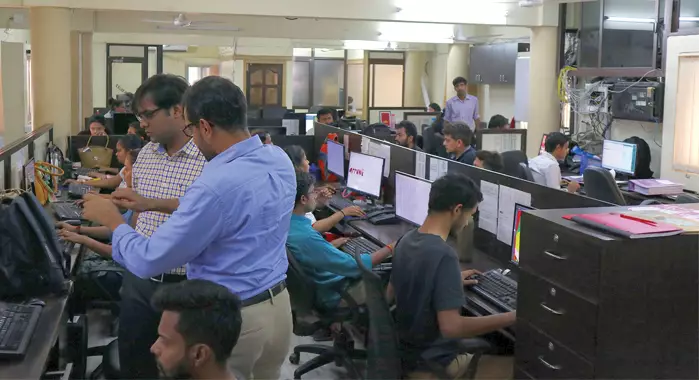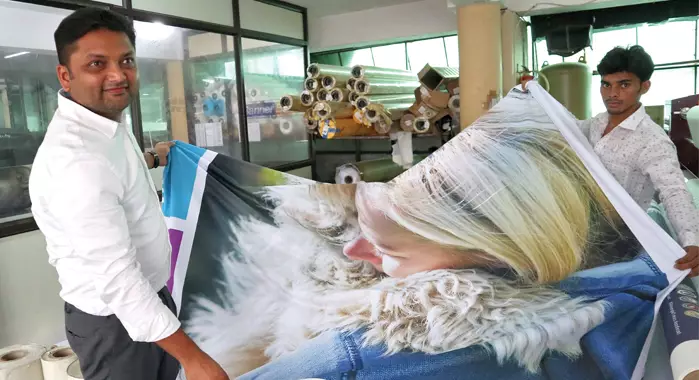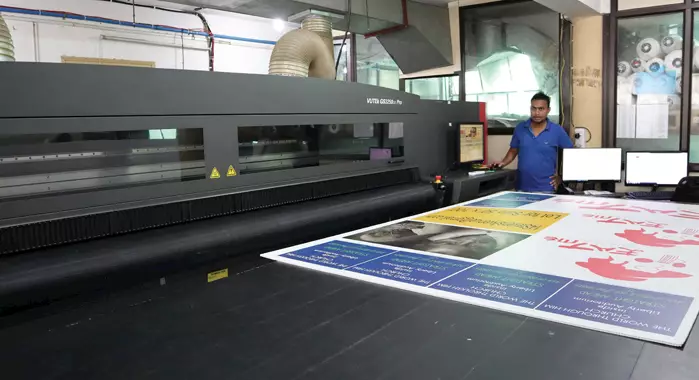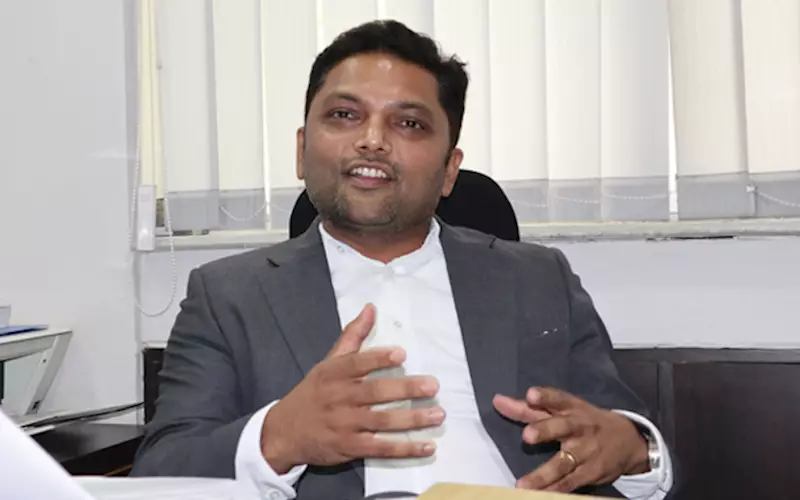Nishant Shah, the CEO and managing director at Caterpillar Signs, a US-based company which has set up a plant in Ahmedabad, tells Noel D’Cunha why the India plant is as valuable to him, as it is to Caterpillar Signs
There is something alluring about a product, especially when you come across one that you constantly need, but is not part of your business. It fascinates you. “It’s a funny story,” says Nishant Shah, the CEO and managing director at Caterpillar Signs, who in 2004 started a car wash business in the US. “It was a business where I constantly needed signages for promotions. I sourced it from local companies.”
If you’re curious, there is always something new to be discovered in the backdrop of your daily life, goes a saying. “I started talking about the products, markets in the signage industry,” says Shah. Then in 2005, Caterpillar Signs was born. The company started producing vinyl banners for companies that needed them. Later it upgraded its portfolio to include window signs, yard signs, for those same customers who demanded vinyl earlier.
Today it produces more than 500 products in the US ranging from vinyl and flex to board and rigid surfaces like glass and metal using a raft of wide-format printing technology like UV, latex, solvent and eco-solvent, dye-sublimation and direct cloth printing and UV flatbed equipment from EFI, HP, Roland, Flora and Monti.
The India foray
Caterpillar Signs expanded, built an online platform Giant Media Online, and started serving the markets in Europe and Asia-Pacific. “We started exploring the idea of producing in India, because whenever I came to India, I used to procure some of our requirements here,” said Shah.
Shah says, there are cost benefits as well as delivery becomes easy if products are produced closer to the market. “We have two large manufacturing units in the US, but our portfolio is such that there are seasonal variations in the product demands,” says Shah. So, five years ago, the company set up a unit in India, CP Graphics, a 20,000 sq/ft site in Ahmedabad equipped with equipment similar to that in the US plant. “The plant served as a backbone when demands were high or when we had a unique situation,” says Shah.
In the five years, Caterpillar has built a good capacity in India. There are two plants, one of which is a five-storey building which has sixteen machines, including three brand new EFI Vutek GS 3250LX Pro, a 10-colour UV LED curing inkjet printer. The other is a 20,000 sq/ft storage and stitching where the new EFI Reggiani textile printer is installed.
Selling in India, maintaining standards
Though Caterpillar Signs produced different signage products in India, it did not intend to sell in India. “We were very conscious of the price competitiveness of the market. We maintain a certain standard and quality. For example, if there’s a scratch in a 10x40-ft signage, we simply reject it,” says Shah. He adds, “Being an Indian, the market is close to my heart. When I went to an awards function, I saw a standee, and something in me told me, that it’s not a product for the occasion. That’s when I decided that we will also sell in India, because there are lots of global as well as local brands who are quality conscious and we could serve them.”
With more high-value brands coming to India, Caterpillar Signs saw an opportunity of catering to companies and brands that are looking for premium products and services. “With years of experience in US, Canada, Australia and UK markets, last year we decided to start executing selective projects in India,” says Shah.
For Caterpillar, quality begins right at the stage when the order from the clients is received. The pre-press department works closely with its customers to understand what the requirements are and understand their campaign or the project. Once this is finalised, getting the desired colours and sampling is done in tandem with the customers, before it goes into production.
Shah says, compared to our international business where we always have focused on providing better quality products, fast turnaround and after excellent sales service, India is little different. “Here we have to inform the customer on quality difference and how with premium quality and service we provide better value. Most of the world has moved to UV printing and soft signage, India is still dominated by solvent printing.”
Shah believes that the monitors on which the products are processed and machines need to be calibrated often, rather than standardising the software. “The aim should be to achieve the colour your client desires. When we print a red, we make sure that it’s the red the client wants.” Shah gives an example. “We printed a maroonish red for a US company named Liberty. We had 12 shades of it printed. I could not find any difference in the shades. But after it was scanned, we got the correct one. That is the kind of quality that we ensure.”
Shah also believes that in production, you can have a machine that produces a Rs 15-lakh job as well as a Rs 3-crore job. “Achieving consistency in work is of importance, which comes with good printing presses. We cannot take up a job knowing that the results achieved will be 99% and not 100%,” says Shah. And for that, the company has a training system in place. “If you look at the grooving in our banners, it’s not manual. We use automated grooving machines. There’s no compromise when it comes to quality assurance and control.”
Price game and customer profile
Caterpillar Signs is registered with clients like Blackberrys Pantaloons, Gitanjali Jewellers, Orra Fine Jewellery, Piramal Healthcare, Unicorn Infosolutions and Jio among the forty brands it engages with. “The kind of work we want to do require a long lead. We are in the process of customer building,” says Shah.
Considering that the Indian market is a price sensitive one, where printers would rather opt to buy an affordable machine, while the brands look for printers with the best machine, but do not want to pay for the quality.
“That’s been a struggling point for us,” says Shah. “One thing we learnt when working on the Jio project is: if you improve the efficiency of the process then you can achieve maximum cost-efficiency. If you are capable of running the machine for 18 hours a day, reducing the downtime and wastages, then it comes ahead of the new technology.”
But the signage business is a crowded place. And any innovation a company does is quickly replicated. As a result, the differentiation appears little. Caterpillar has risen to the challenge – working on aspects of its customer relationship, positioning itself as an honest supplier, which Shah says, has helped the company increase its business. “In case of Jio work, we didn’t want to overcharge them. We explained them all the process involved in the production and the value they will achieve for cost quoted by us. Jio was happy and accepted the cost for the job. I cannot expect the customer to pay me more for the performance of a machine that is not providing my clients with the prints they want.”
Building a brand
The company has done its research. Their findings: A signage printer’s 100% supply is focused on 75% to 80% of the market, which is cost-driven, working mostly with printers which can produce just CMYK running only for production.
“We work on CMYK + light colours. This reduces the press speed, but the colour we achieve is amazing. This is where we differentiate ourselves,” says Shah. “We are building a brand.”
Caterpillar Signs also provides services as a complete package, working with eight to 10 fabrication companies. The company’s quality assessment person manages the fabrication operations to ensure the work is as per the requirement.” One of our USP is our logistic. “If we are supplying worldwide from this location, then it is very evident that we have sophisticated logistics system. We have DHL, Blue Dart and other travel companies who look after the logistics,” explains Shah.
Challenges and way forward
The last twelve months have been excellent, says Shah. “We have seen an 800% growth for the India operations.” The company’s India operation produces 40% of the jobs it produces for the global market, which is approximately 60,000 sq/ft print of the total 1,60,000 sq/ft. The rest is produced in the US.
“We have got very encouraging feedback for work we have done. Currently, we are being selective on projects that we take as we do not want to dilute our quality. We believe that customer values have to match ours as we believe in a long-term relationship with our customers as a solution provider than just a product provider,” says Shah.
One of the biggest challenges for any company, Shah says, is selecting the right project and customer/partners. “We believe in having the right client,” says Shah.
But what about business risk, as the company has just started selling products. A confident Shah, explains, “As business risk is concerned, our Indian business accounts only for 1%. We have 1,00,000 customers all over the world. As far as the market, we have diversified products in the global market. This also boosts our product portfolio. At any given time we have 1,00,000 flags in stock in India owing to the geographical distribution of the products.”
There is enough work to be done but we have to be careful on picking the right work, says Shah. “In India, we see soft signage and UV printing as emerging trends and that is where we would like to focus. We have been doing UV and direct fabric and dye-sublimation printing in the US for over 15 years and we’re ready for the Indian market with best equipment infrastructure in the country.
We will also be focusing on bringing more exhibition displays to the Indian market and more environment-friendly printing products.”
Shah comes from a place where 80% of the businesses are driven by major companies. He is not perturbed with the ways the Indian wide-format market functions. “It’s unorganised, that’s why one can see such quality differences in the products. We see this as an opportunity. If people see better quality, they will ask for better quality, simple.”
Shah concludes, “India is an exciting place to be and we see Caterpillar as one of the key players in high-quality printing and branding market.”
Factfile
Founded 2005
Specialty Signages
Plant location Two manufacturing plants of 20,000 sq/ft each in Ahmedabad
Equipment UV, latex, solvent and eco-solvent, dye-sublimation and direct cloth printing and UV flatbed equipment from HP, Roland, Flora and Monti. Three EFI Vutek GS 3250LX Pro, EFI Reggiani, among others
Total print output 1,60,000 sq/ft
Staff 200














 See All
See All